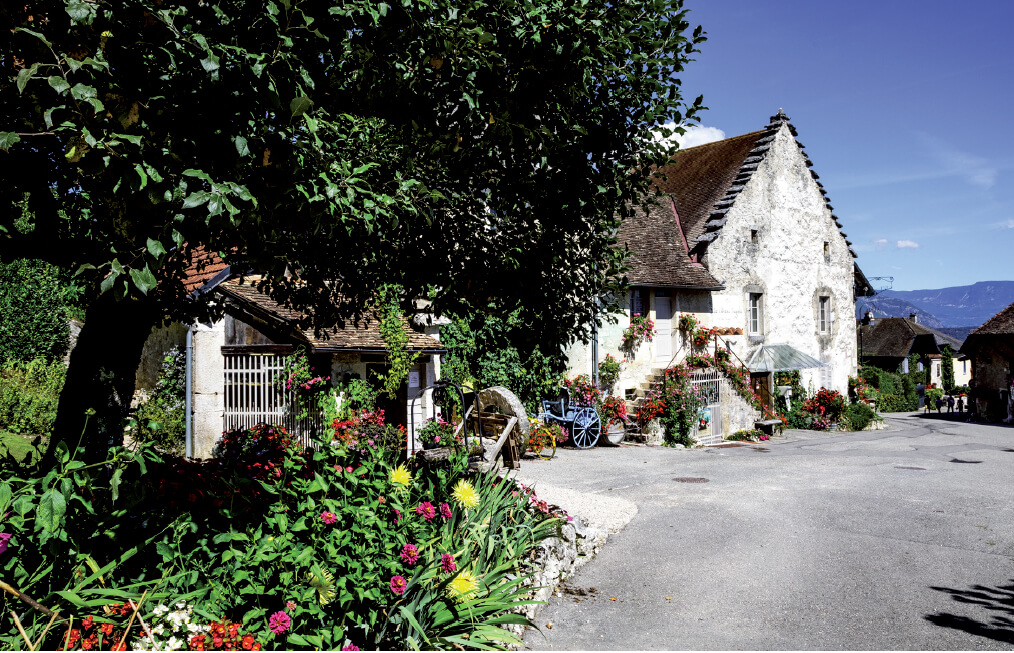BUGEY
Bugey is the historical name for the southeastern part of the Ain department and gives its name to the department’s main wine region. With less than 500ha of AOC vineyards, it is often – in books, magazines and wine lists – wrongly subsumed into Savoie, yet some wine producers feel closer to the Jura, just to the north, than to Savoie to the east. The region’s wines and wine producers deserve exploration, if possible in situ, for this is a gorgeous area to spend a few days. It is a land of low mountains and villages with stone-built houses, often with distinctive stepped roofs covered in lauzes, stone tiling. A notable and attractive feature is the small vigneron buildings scattered across the vineyards, here named grangeons. A few are being restored.

In Vongnes, the tasting room of Caveau Bugiste is in a restored village house, with its distinctive lauzes-tiled roof.
Both geographically and wine-wise, the story of the region is a tale of two halves, northern and southern Bugey. Geologically, Bugey is part of a southern extension of the Jura mountains, which peter out here in a series of fingers stretching south towards the Isère department. The similarity to the Jura wine area is more visible in the landscape and villages in northern Bugey, which lies not far east of the Ain capital, Bourg-en-Bresse. Its speciality is the sparkling rosé Méthode Ancestrale wine Bugey Cerdon. Southern Bugey includes the town of Belley, which is situated just above the Rhône and is the wine region’s administrative centre. The vineyards and wines here have more in common with Savoie in terms of growing conditions and grape varieties. However, Chardonnay (especially used for brut traditional method sparkling wines) and Pinot Noir outstrip the Savoie grapes in terms of quantity.
This chapter is divided into a part on northern Bugey, a second on southern Bugey and a final small section on the IGP Coteaux de l’Ain (this IGP label may be used by producers within the AOC Bugey areas too).

The village of Cerdon and La Grande Côte vineyard slope. To the left are some of the steep vineyards of Mérignat.
Bugey AOC figures (2016 vintage)
Production levels for vintage 2016 represents a reasonable average of the past decade; vintage 2018 appears to be similar, whereas vintage 2017 overall was over one-third lower compared to 2016 due to frost damage, with Cerdon production being 42% lower than in 2016.
Area under vine: 466 hectares, of which Bugey Cerdon is 177ha
Volume produced: 26,015 hectolitres (approximately 3.5 million bottles)
(% of production)
Cerdon |
47% |
Other sparkling wines |
18% |
White still wine |
21.5% |
Red still wine |
10.5% |
Rosé still wine |
3% |
Main grape varieties (% of total Bugey):
Gamay |
43% (mostly for Cerdon) |
Chardonnay |
33% |
Pinot Noir |
6.5% |
Altesse |
6% |
Mondeuse |
3.5% |
Poulsard |
3% (for Cerdon) |
Négociants and co-operatives
There is no major négociant in Bugey; however, several producers have négociant status and buy in grapes from other growers. In the Cerdon area these include Lingot-Martin (the largest northern Bugey producer), Renardat-Fâche, Vucher and La Dentelle. In southern Bugey the largest buyer of grapes is Caveau Bugiste (the largest southern Bugey producer); others who buy some include Yves Duport and Maison Guigard, which is not covered in this book and buys somewhat less each year. Some Savoie négociants, including Philippe Viallet and Adrien Vacher, buy a little Bugey wine in bottle; Maison Mollex in Seyssel sold much Bugey wine in the past. From 2018, Des Vins d’Envie in Savoie has bought some organic grapes from Bugey. There has never been a wine co-operative in the Bugey area: both Lingot-Martin and Caveau Bugiste are often wrongly designated as co-operatives by writers or other wine trade visitors.
Where the wines are sold
The vast majority of Bugey wines are sold in the region and big efforts have been made to sell in the nearby city of Lyon. Despite these efforts, it can be hard to find a variety of Bugey wines in shops; often the only solution is to buy direct from the producers. Beyond these areas a few producers participate in wine fairs around France, selling direct to consumers; organic producers in particular are finding markets beyond the region. Exports are estimated as representing 5–7% of sales.
Bugey is using various initiatives to encourage wine tourism to increase both sales and recognition of the region. The annual spring festival Le Printemps des Vins du Bugey and the activities held during Le Fascinant Weekend every October (see details about both here) aim to attract visitors to come to meet the Bugey vignerons in the wine region and taste their wines, often alongside local foods. Tasting rooms are increasingly open at weekends too.